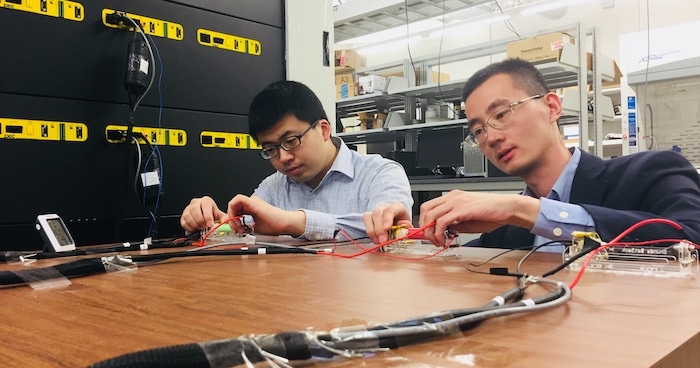Apr 22 2019
There is a good chance a lithium-ion battery is present in a person’s pocket, driving their mobile phone or e-cig. If there is a laptop computer in the backpack, it undoubtedly works on a lithium-ion battery. Or if one might be driving a Chevy Volt Toyota Prius, or Tesla, it surely is powered by a large number of lithium-ion battery cells integrated together. These batteries also have been used in numerous things from Boeing 787 jets to U.S. Navy ships.
 University of Kansas researcher Huazhen Fang (right) and a doctoral student perform battery tests (with battery tester in background). (Image credit: Huazhen Fang)
University of Kansas researcher Huazhen Fang (right) and a doctoral student perform battery tests (with battery tester in background). (Image credit: Huazhen Fang)
As beneficial and widespread as lithium-ion batteries have become, they also pose a certain risk. Since lithium metal is extremely reactive, these batteries and cells can undergo “thermal runaway,” meaning they can overheat and catch fire or sometimes explode. Though occasional, these incidents — like when an aircraft’s lithium-ion battery overheated last year on a flight to Paris — have received headlines and raised public fear over lithium-ion technology.
At present, aided by a new five-year, $500,000 grant from the National Science Foundation, a scientist from the University of Kansas is designing technology to track and prevent overheating in lithium-ion batteries. Huazhen Fang and his students will formulate machine-learning methods for checking temperature inside the batteries.
Nowadays these lithium-ion batteries are everyplace in our society. They’re popular because they have many advantages, including high energy and power density, long cycle life, high voltage compared to other batteries and a low self-discharge rate. During the past decade, lithium batteries have become the most popular batteries for energy storage. But they’re vulnerable to thermal events. They can easily catch fire or have thermal explosions when ambient temperatures are high or when some internal failures occur. That’s because the lithium metal is highly reactive, and the commonly used electrolyte is flammable.
Huazhen Fang, Assistant Professor, Department of Mechanical Engineering, University of Kansas.
Presently, a majority of technologies to monitor the temperature of lithium-ion batteries are insufficient because sensors only can read the outer surface temperature of the batteries, according to the KU scientist.
Usually, the temperature on the surface is insufficient to tell us about the state of the cell. The internal temperature would tell us more about thermodynamics. But today there are few methods to place sensors inside a battery. However, using artificial intelligence and machine learning, we can predict the temperatures inside the cell that would give us the leverage to detect its behavior. The temperature at the surface would provide abundant data to be fed to a machine-learning approach and combined with mathematical models to predict what’s going on inside the cell.
Huazhen Fang, Assistant Professor, Department of Mechanical Engineering, University of Kansas
Instead of assuming an even temperature throughout a battery, as is the case with an existing modeling method called “lumped parameter models,” Fang said his computer-learning method could predict differences in internal temperatures inside a battery — a more accurate and realistic means to measure a battery’s potential to experience thermal runaway.
“When charging or discharging, the temperature distribution is uneven — usually higher inside near the electrodes — but the temperature outside on the surface is lower,” he said. “Lumped models only consider even temperature distribution, but our method provides spatial-temporal reconstruction of the temperature.”
Fang said data from a lithium-ion battery transmitted into artificial intelligence to infer internal temperatures could be processed in the device driven by the battery, or connected to cloud computing. If a battery experiences thermal runaway, the device would be set to shut down or disconnect the battery before it becomes too hot to catch fire or cause an explosion.
With these improvements, lithium-ion batteries could be expanded up to more industrial levels via cells that bundle numerous batteries together. According to Fang, lithium-ion technology progressively could be used in enormous electrical grids to store and discharge electricity produced by sustainable technologies like wind and solar.
“The problem is more pressing for large systems as they face higher vulnerabilities,” he said. “In large systems, if one cell catches fire, then a domino effect will devastate the entire system. Nowadays, people across the industry are thinking of developing larger-scale energy storage based on lithium-ion systems. But the thermal-safety issue could slow the pace of the use of lithium-ion batteries for future grid energy systems. If successfully accomplished, our project can help address this challenge and widen the deployment of lithium-ion battery technology to make our society more sustainable.”
As part of the research under the new grant, several KU students will be trained in the battery modeling, machine learning, and data analysis to create the preferred models and approaches that will potentially drive the thermal safety of batteries to new summits.
Furthermore, Fang will continue his collaboration with the Youth Services Department of Douglas County to bring well-structured outreach to kids and teens locked up in juvenile detention, offering them an extra opportunity to STEM education and training that is enjoyable and stimulating.
I want to do that because there are many young people in detention in the U.S. According to the Department of Justice, there are about 60,000 young people between ages 10 to 18 incarcerated every day across the country. Some studies show they have less access to high-quality education, even though it’s so important to their future life. In particular, they are generally underserved in STEM education compared to their peers in public schools. I hope to inspire students’ interest in education and even careers in STEM areas and help them get prepared for a brilliant future.
Huazhen Fang, Assistant Professor, Department of Mechanical Engineering, University of Kansas